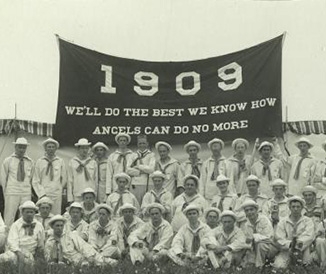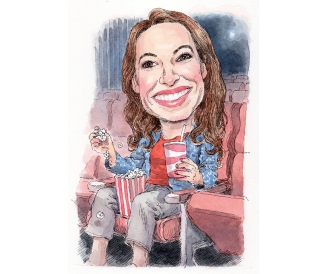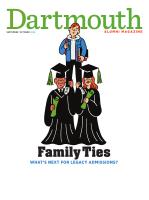
Keeper of the Golden Gate
“The rhododendrons are blooming in Golden Gate Park!” Every springtime, for many years, this message was communicated to the inhabitants of San Francisco on the side of buses, with placards on City Hall Plaza, on billboards across the city. The flowering shrubs are, indeed, blooming their fool heads off this spring, as I jog through them with classmate Phil Ginsburg. We’re keeping what is a gentle pace for him, a guy who has run marathons.
At 1,017 acres, Golden Gate Park is slightly bigger than New York’s Central Park and draws 13 million visitors per year. Ginsburg, general manager of this and 219 other parks mainly within the city, is often in the news as his department’s decisions are debated: Those new bright lights above the soccer fields will surely distract migrating birds. Why astroturf, not natural grass? How dare the longtime concession-holders at Stow Lake be displaced. “My wife sometimes tells me I shouldn’t read this or that, which means I immediately track it down,” says Ginsburg.
He, doctor spouse Emily and daughters Grace and Sarah live on the southern edge of the park, and the lawyer has been jogging there for years. One morning he came across a coyote. On another he stopped to help a disoriented woman get her bearings. “I know this place so well—when they asked me to consider this job, I didn’t hesitate for too long,” he says.
As GM, Ginsburg reports to a commission appointed by the mayor and administers a department budget of more than $125 million. His salary is around $200,000.
The night before our run a downtown gala celebrated Ginsburg’s contributions to the city (and those of two other prominent locals) while raising money for a children’s soccer charity. Former mayor Willie Brown set the evening’s tone: “I should know better than to pick up the phone when Phil calls. There’s always an event he needs me to come to. And he always says I need to come for the kids. I can’t say no to the guy.”
Brown has known Ginsburg for years, through several incarnations at City Hall. After Dartmouth Ginsburg studied law at UC Hastings. He stayed in San Francisco, joining a top labor and employment practice. The government major jumped at a chance to work for the city, notwithstanding the pay cut, and wound up running its human resources department before serving as Mayor Gavin Newsom’s chief of staff.
In San Francisco the number of dogs has reportedly surpassed the number of children, and Ginsburg, in his speech, articulates his big vision for the rec and parks department: offering more amenities to help persuade families with young kids to stay in the city. He reels off the figures: Thirteen percent of the city’s residents are under the age of 18, compared with 25 percent in nearby San Jose and 21 percent across the Bay in Oakland. “In 1970 San Francisco had 22 percent kids,” he says. “We want to be part of what keeps families here.”
He has ambitious plans for a city that dramatically cut its budget after the 2009 financial downturn, when Ginsburg accepted his current position. A half-billion-dollar city deficit had resulted in a 20-percent reduction in funds allocated for parks. Undeterred, Ginsburg convinced voters to pass a $200-million bond measure and established partnerships with private charities and businesses to pay for better lighting at soccer fields and more summer day camps, keep swimming pools open longer and keep a rec center in a poor neighborhood open one extra day per week.
On our jog through the rhodos, we lope past two starchitect-designed museums, the AIDS Memorial Grove of redwoods and the torii at the entrance to the Japanese Tea Garden. Ginsburg is not happy to spot a homeless encampment in a stand of eucalyptus. His personal views on homelessness are liberal, and he knows some of the park’s frequent visitors by name, but the city has ordered that they not stay on the grounds overnight, and Ginsburg wants the park to be a showpiece for the annual Bay to Breakers run during the upcoming weekend.
The big picture for Ginsburg is increasing the parks’ utility for working families, but he pays a lot of attention to the small picture as well. “He’s the boss who knows things,” a friend says. “He’s totally hands-on and very little gets by him.” Every Friday Ginsburg dons a rec and parks orange vest and joins a gardening crew somewhere around the city. “They assign me the usual tasks: picking weeds, putting on mulch, hooking up a sprinkler,” he says. “If I get to use the chainsaw, it’s a good day.”
His participation in the nitty-gritty of maintaining these urban green spaces is meant mainly as a morale builder for his staff, but the city’s chief of police, Greg Suhr, says Ginsburg revels in this part of the job: “It’s very nice to have a very sharp man who’s still a little boy heading up this department. Phil is forever in the vest, regardless of the formalness of the situation.”
As we jog and my puffing increases, Ginsburg takes pity on me and we slow to walk toward John McLaren Lodge. Named for Ginsburg’s most famous predecessor, it’s located where the park ends and the city begins. There’s Dartmouth regalia in his large, ground-floor office (an oversized diploma, a Big Green sweatshirt) and some California landscape paintings.
“In a way it’s a very Dartmouth job,” says Ginsburg. “It’s about the outdoors, like so much of the Dartmouth experience was. I’ve tried to bring to it that same sort of good spirit we had on campus.”
Is his job like the Amy Poehler show, Parks and Rec? “Usually TV versions of my work are way off,” he says. “L.A. Law was nothing like the practice, Spin City not too similar to running a mayor’s office, but Parks and Rec is right on.”
He says he views himself as the representative of real people with stuff to do. “They don’t have time to come to meetings,” says Ginsburg, “but they have concerns, things they want from the parks, all the same.” And what is the most intractable problem he faces on a daily basis? “There will be peace in the Middle East before we are able to solve the on-leash, off-leash dog issue,” he says.
Alec Scott is a freelance writer based in the San Francisco Bay Area.










